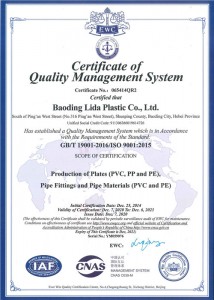Dec . 18, 2024 18:02 Back to list
ppr tube
Understanding PPR Tubes The Modern Solution for Plumbing Needs
In the world of plumbing and construction, the materials used can greatly affect the quality, durability, and efficiency of the systems we install. One noteworthy advancement in this area is the use of PPR tubes, or Polypropylene Random Copolymer tubes. These innovative pipes have gained popularity worldwide due to their remarkable properties and benefits, positioning them as a modern solution for a variety of applications.
What is PPR?
PPR stands for Polypropylene Random Copolymer, a type of plastic that is known for its high resistance to temperature changes and chemical corrosion. PPR tubes are manufactured through a polymerization process that creates a flexible yet strong material. Unlike traditional materials like copper or PVC, PPR offers a range of advantages that make it an ideal choice for both residential and commercial plumbing systems.
Advantages of PPR Tubes
1. Durability and Longevity One of the most significant benefits of PPR tubes is their durability. These pipes can withstand high temperatures, typically up to 95°C (203°F), making them suitable for hot water applications. PPR also resists calcification and corrosion, which ensures that they maintain their structural integrity over time.
2. Lightweight and Easy to Handle PPR tubes are much lighter than metal pipes, which makes transportation and installation straightforward. This is particularly beneficial for construction projects where efficiency and speed are essential. Their lightweight nature reduces the physical strain on workers and makes it easier to manage the material on site.
3. Cost-Effectiveness Although the initial investment in PPR tubing may be slightly higher than some traditional materials, the long-term benefits, such as reduced maintenance costs and a longer lifespan, make it a cost-effective choice overall. Additionally, the ease of installation can save labor costs, further enhancing the economic advantages of using PPR.
ppr tube

4. Versatile Applications PPR tubes are remarkably versatile and can be used in various applications, including hot and cold water distribution, heating systems, and even industrial liquid transport. Their resistance to chemicals makes them an excellent choice for transporting aggressive substances in industrial settings.
5. Environmentally Friendly PPR is made from polypropylene, which is a recyclable material. Using PPR tubes contributes to sustainable construction practices, as they have a lower environmental impact compared to traditional materials like PVC, which can release harmful chemicals during production and disposal.
Installation and Maintenance
The installation of PPR tubes is relatively uncomplicated. They are typically joined using a heat fusion process, which involves melting the edges of the pipes and fitting them together, creating a robust and leak-proof seal. This method minimizes the risk of leakage that is often associated with threaded joints in metal piping systems.
When it comes to maintenance, PPR pipes require very little attention once installed. Their resistance to corrosion and buildup means that they can operate efficiently without the need for regular maintenance checks or replacements, which is ideal for busy households or commercial environments.
Conclusion
In summary, PPR tubes represent a significant advancement in plumbing technology. With their impressive range of benefits—including durability, cost-effectiveness, versatility, and environmentally friendly attributes—it is no wonder that PPR tubes are becoming a preferred choice for modern installations. As the demand for reliable and efficient plumbing solutions continues to grow, PPR technology will likely play a crucial role in shaping the future of plumbing systems, making it an essential consideration for builders, architects, and homeowners alike. Whether for new construction or renovation projects, investing in PPR tubes is undoubtedly a step towards a more efficient and sustainable plumbing infrastructure.
-
Durable PP Rigid Sheet: Lightweight, Chemical Resistant Solutions
NewsAug.21,2025
-
PVC Grey Sheet for Extraction: Chemical Resistant & Durable
NewsAug.19,2025
-
Durable PVC Pipe Fittings for Plumbing & Irrigation Needs
NewsAug.18,2025
-
HDPE Steel Belt Reinforced Spiral Corrugated Pipe | High Strength
NewsAug.17,2025
-
HDPE Pipe Fittings: Durable, Leak-Proof Solutions
NewsAug.16,2025
-
Premium CPVC Sheet: High-Temp & Chemical Resistant Solutions
NewsAug.15,2025

